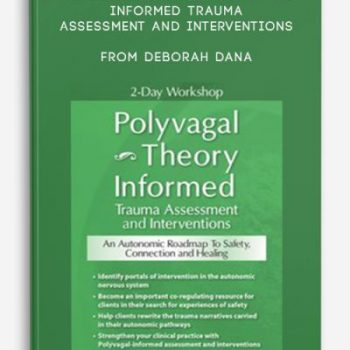2-Day Workshop: Polyvagal Theory in Action – Deborah Dana
Description:
Have you had a client who could out-think their trauma? Likely you haven’t… because trauma isn’t healed through thought.
Clients come to us looking for ways to feel safe and regulated in their daily lives – but the trauma client is often stuck in a dysregulated state.
Like us, they want to be able to navigate the normal “shifting” we do in our daily life – transitioning from one state to another. Hyper to calm, irritated to relaxed, overwhelmed to feeling in control.
In the words of author of The Polyvagal Theory in Therapy (Norton) and international trainer Deb Dana, LCSW, they are “longing to come into a state of regulation”.
And it’s our job to help them. It’s what we trained for, what we dreamed of doing, and where we get the deep satisfaction from the work we do.
By watching this two-day applied training, Deb will give you:
A deep knowledge of Polyvagal Theory – in easy to understand language
Practical ways to work with the autonomic nervous system that create connection and safety…through techniques she’s honed and will share with you
The Polyvagal approach is not a model of therapy or a protocol to follow. It is an understanding of three organizing principles around which you can create your own approach and technique, blending them with your preferred model.
The goal is that you leave the training inspired to try something new with a client — and that you have a roadmap to do so effectively.
Each client is unique, each therapist unique, and each approach unique, but using the foundation of our autonomic nervous system and working with states of engagement and dysregulation are universal ingredients for clinical success to happen. Learning Polyvagal Theory and how to apply it in your practice may become one of the most transformational moments in your career.
Increasingly, Polyvagal Theory is being discussed at conferences here and abroad, written about in articles, and taught in arenas of higher learning. Complete this training and revolutionize your practice. It is time to stop being mystified by the name “Polyvagal Theory” and realize the immediate benefits of knowing and incorporating its principles in your clinical work.
Outline:
ESSENTIALS OF POLYVAGAL THEORY
Evolution of the autonomic nervous system
How trauma influences autonomic profiles
Three organizing principles
Neuroception: Detection without perception
Hierarchy: 3 predictable pathways of response
Coregulation: The biological imperative
NEUROCEPTION AND THE SHAPING OF AUTONOMIC PATHWAYS
Understand the internal surveillance system
Track cues of safety and danger
Everyday “biological rudeness”
Trauma, autonomic wisdom, and cognitive override
NAVIGATE THE AUTONOMIC HIERARCHY
Exploring three autonomic circuits
Sympathetic branch
Ventral vagal pathway
Dorsal vagal pathway
How trauma shapes cycles of autonomic response
Engage the regulating capacities of the autonomic nervous system
Introduction to autonomic mapping
THE SOCIAL ENGAGEMENT SYSTEM
The five elements of the Social Engagement System
What happens when parts of the system are unavailable?
Using the Social Engagement System to regulate states
Exercising the Social Engagement System
TRACKING AUTONOMIC STATES
Seeing patterns over time
Use micro-moments to resource change
Explore the blended states of play and stillness
Create autonomic anchors
MEETING THE BIOLOGICAL NEED FOR CONNECTION
Mapping the continuum of solitude to sociality
Create safety in co-regulation
Working with the cycle of reciprocity – rupture – repair
SHAPING THE AUTONOMIC NERVOUS SYSTEM TOWARD SAFETY
Identify portals of intervention
Create neural exercises
Use breath as a regulator
Resourcing new patterns through movement
Explore the autonomic response to touch
Use autonomic imagery
INCORPORATING POLYVAGAL THEORY IN CLINICAL PRACTICE
Getting comfortable teaching Polyvagal Theory to clients
Tracking the 8 steps of a Polyvagal-Informed clinical session
Polyvagal-Informed assessment and treatment planning
Polyvagal Theory and Phase I trauma treatment
RESPONSIBILITIES OF A POLYVAGAL-INFORMED THERAPIST
The guiding questions
Ethical considerations
Research limitations and potential risks
NLP online course
So what is NLP?
Firstly, NLP stands for Neuro-Linguistic Programming. Secondly neuro refers to your neurology;
Thirdly linguistic refers to language however, programming refers to how that neural language functions.
As a result,In other words, learning NLP is like learning the language of your own mind!
Moreover, NLP is the study of excellent communication–both with yourself, and with others.
It was developed by modeling excellent communicators and therapists who got results with their clients.
NLP is a set of tools and techniques, but it is so much more than that.
In conclusion, It is an attitude and a methodology of knowing how to achieve your goals and get results.














tristian –
This is Digital Download service, the course is available at Vincourse.com and Email download delivery.